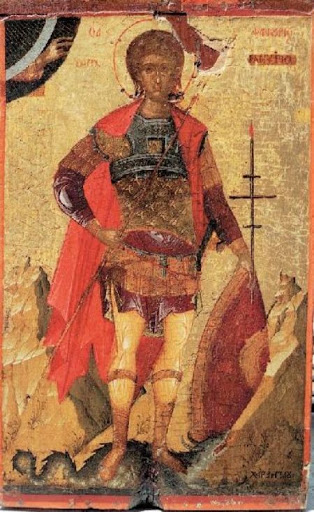Register a SNAP EBT card with Amazon

Try Amazon Fresh
Byzantine Icons painted by Angelos Akotantos, Venetian Crete, 2nd Quarter of the 15th Century

Saint Theodore Stratelates slaying a dragon.

Icon of Saint Phanourios, painted by Angelos Akotantos (second quarter of 15th c). From the cloister of Virgin Hodegetria at Pyrgiotissa, now part of Agia Aikaterini Collection, Heraklion.

Icon of Saint Phanourios from Megali Panagia on Patmos island.
Source: Protostrator: The Cretan Guard - Real or not?
Referenced as plate H4: Cretan guardsman. The warrior is copied from an icon of the Cretan school, in the church of Megali Panaghia, Patmos;
details are supplied by two other icons showing similar armour.
Note the cuir-bouilli upper arm defences and decorated leather corselet worn over a long-sleeved mail hauberk;
although it is akin to the Eastern Roman tradition, Prof Babuin has interpreted this as of Italian origin.
These items of equipment are therefore an accurate representation of the appearance of mercenary troops in service during the last decades of the Empire –
and especially of those Cretans who, notwithstanding Venetian rule, felt it their duty to loyally serve the holy Emperor of Constantinople.
The Varangian Guard 988-1453 (Men-at-Arms 459) by Raffaele D'Amato.

Icon of Saint Phanourios slaying a dragon.
Source: peri-grafis.net
See also Cretan guardsman in The Varangian Guard 988-1453 (Men-at-Arms 459) by Raffaele D'Amato
Christ Bearing the Cross, by Nicolaos Tzafouris, Crete, second half of the 15th century.
Byzantine Illustrations of Costume and Soldiers





